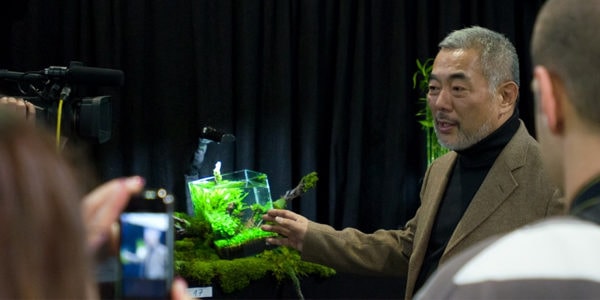When you are passionate about something, you find out there is more about your passion than what you thought. For some people, aquascaping is nothing but a nice hobby, but others live for it.
A perfect example of a legendary aquarist is Takashi Amano, a man who created extraordinary things for the aquascaping industry and elevated aquascaping from a simple hobby to a real art.
You may have been unaware of his life until now; however, you have probably read some of his articles and used the great information that he provided without even knowing the source.
His career and interest for nature started in 1975 when he visited several landscapes in the Amazon and West Africa where he learned more about the world surrounding him.
He focused on these settings by photographing extraordinary pictures of untouched nature; his photos were later used in exhibitions all around the world. From that moment on, it was just a matter of time until he became famous in the world of aquascaping.

When he realized how beautiful nature could be, he began participating in different events and discussions about protecting the environment. He was also a strong supporter of tree planting programs, as well as numerous charity organizations.
A few years later, Amano became interested in the underwater world, focusing on studying diverse species of fish and aquatic plants. He discovered a freshwater shrimp that could be utilized in aquariums due to its ability to consume immense amounts of algae.
He decided to order thousands of them to study the effects they would have on aquariums and introduce them to the aquascaping world. Today, this shrimp is used in multiple types of aquariums instead of complicated filters. For his efforts, Amano was honored by having this shrimp named after him, the Yamato Shrimp.
As his passion grew, Amano discovered more than any other aquarist in the aquascaping niche. In 1994, he published Nature Aquarium World, a series of three books about aquatic plants and fish. The books are considered to be some of the best in the aquascaping genre; the majority of beginners turn to his books for instructions on how set-up aquariums or to take care of fish.
In 1997, he published Aquarium Plant Paradise, a complete guide on how to grow, cultivate, and take care of aquatic plants. He explained the importance of growing certain plants while keeping specific fish and how to use these plants for the benefit of the entire tank.
After he studied the aquarium components that were present on the market, he decided that he needed something more.
Soon after, he developed his own line of components that were advanced and easier to use than anything else on the market. His line is known as ADA and the devices are still considered to be the best in the industry.
Amano did not just stop there; he wanted to bring something innovative to the world of aquascaping. He learned the importance of plants in a healthy fish tank, thus he invented a new, distinctive style of arranging the plants to allow the fish to receive all the light they need while still having places to hide from predators.
As much as he loved aquariums, he always wanted to ensure his aquariums resembled the ocean floor, which is why he did not introduce any artificial decorations or equipment unless it was completely necessary.
Since he learned how to use the shrimp to control the excess algae, his attempts were successful.
In 1982, Takashi Amano started Aqua Design Amano, a company providing equipment for tanks and aquatic plants, for which he had great success.
In 1992, he published Nature Aquarium, a collection of photographs and articles and followed that with Mitzu-Shizen eno kaiki, a book about marine planning. Both of the books were international successes and were translated into seven languages.
Also, the articles were published in various magazines around the world, making him one of the most influential professionals in the world of aquarium enthusiasts.
Takashi Amano will always be considered the pioneer of aquascaping with his legacy being present in every fish tank around us. He took the industry from practically a trivial hobby to the well-known and ever-growing field it is today.
His unexpected death on August 4, 2015 in his home country of Japan left his followers and admirers sorrowful, but his aquariums and photographs will leave a legacy and inspiration for generations.
